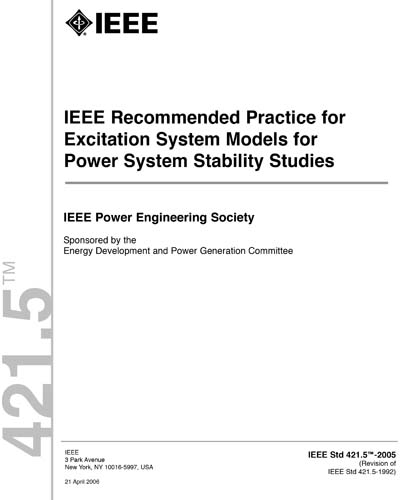Historical
IEEE 421.5-2005
IEEE Recommended Practice for Excitation Systems for Power Stability Studies
When the behavior of synchronous machines is to be simulated accurately in power system stability studies, it is essential that the excitation systems of the synchronous machines be modeled in sufficient detail (see Byerly and Kimbark [B7]. The desired models must be suitable for representing the actual excitation equipment performance for large, severe disturbances as well as for small perturbations.
A 1968 IEEE Committee Report (see [B18]) provided initial excitation system reference models. It established a common nomenclature, presented mathematical models for excitation systems then in common use, and defined parameters for those models. A 1981 report (see IEEE Committee Report [B20]) extended that work. It provided models for newer types of excitation equipment not covered previously as well as improved models for older equipment.
This document, based heavily on the 1981 report, is intended to again update the models, provide models for additional control features, and formalize those models in a recommended practice. To some extent, the model structures presented in this document are intended to facilitate the use of field test data as a means of obtaining model parameters. The models are, however, reduced order models, and they do not represent all of the control loops on any particular system. In some cases, the model used may represent a substantial reduction, resulting in large differences between the structure of the model and the physical system.
The excitation system models themselves do not allow for regulator modulation as a function of system frequency, an inherent characteristic of some older excitation systems. The models are valid for frequency deviations of ±5% from rated frequency and oscillation frequencies up to about 3 Hz. These models would not normally be adequate for use in studies of subsynchronous resonance or other shaft torsional interaction problems. Delayed protective and control functions that may come into play in long-term dynamic performance studies are not represented. See additional information in Annex F.
Where possible, the supplied models are referenced to commercial equipment and vendor names shown in Annex I. This information is given for the convenience of users of this recommended practice and does not constitute an endorsement by the IEEE of these products. The models thus referenced may be appropriate for equivalent excitation systems supplied by other manufacturers.A sample set of data (not necessarily typical) for each of the models, for at least one particular application, is provided in Annex H. A suffix “A” is used for the designation of models introduced or modified in IEEE Std 421.5-1992, and a suffix “B” is used for models introduced or modified in this latest recommended practice, IEEE Std 421.5-2005.
Modeling work outside of the IEEE is documented in IEC 60034-16:1991 [B17]. Additional background is found in IEEE Committee Report [B19].
Content Provider
Institute of Electrical and Electronics Engineers [ieee]






